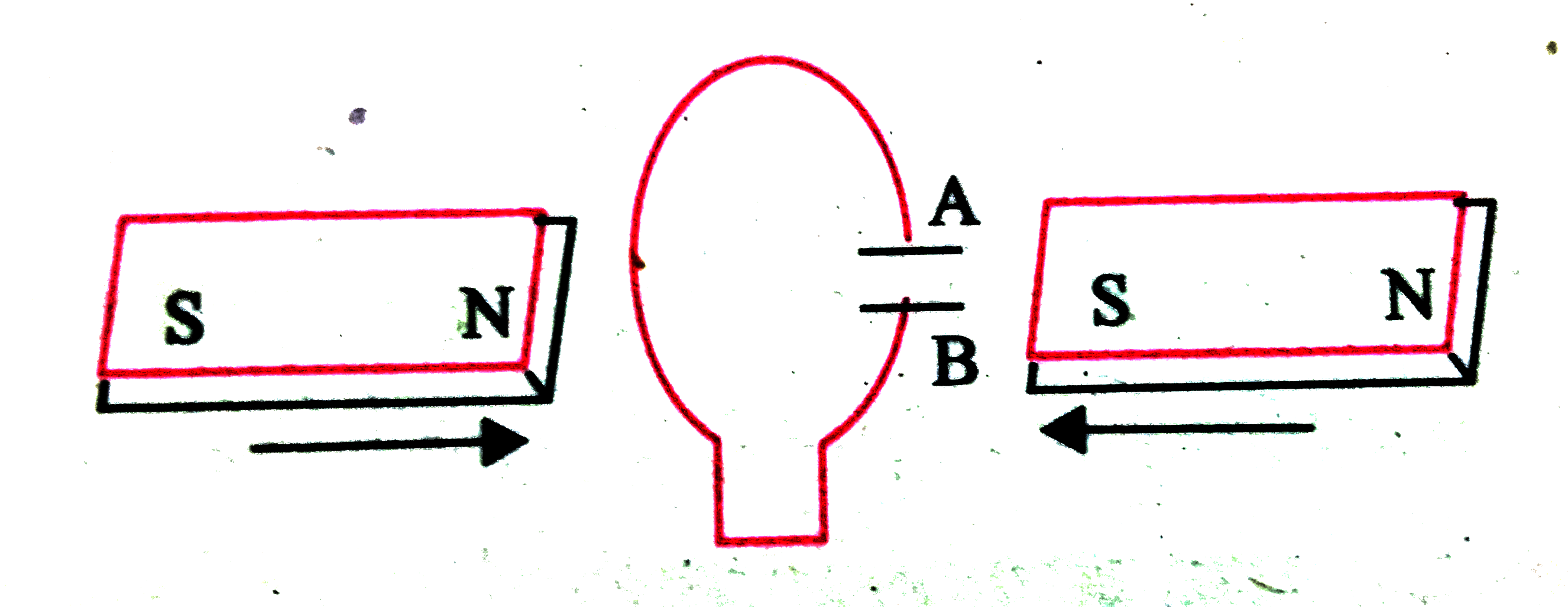A uniform E exiest between two metal plates one negative and other positive. The plate length is l and the seperation of the plates is d.
(i) An electron and a proton start fron the negative plate and positive plane, respactively, and go the opposite plates. which one of them wins this race?
(ii) An electron and a proton start moving parallel to the plates towards the other end from the midpoint of the separation of plates at one end of the plates. Which of two will have greater deviation when they come out of the plates if they start with the
(a) same initial velocity
(b) same initial kinetic energy, and (c ) same initial momentum.
(i) ae=eEme,ap=eEmp,d=12at2
t=√2da or t=√2mdeE
Therefore, we have
tetp=√memp
As me<mp, so te<tp. Hence, electron will take less time i.e. the electrons wins the race

(ii) Time to cross the plates is t=1/u. Deviation is
y=12at2=12eEm(1u)2
or, yeyp=mpme(upue)2
(a) if up=ue then
yeyp=mpme
As mp>me so ye>yp Hence, the deviation of hte electron will be more.

b. From Eq. (i)
yeyp=(mpu2pmeu2e)=1 (as given)
Hence, the deviation of both the electron and the proton will be the same.
(c) From eq (i), yeyp=(mpupmeue)2memp=memp
As me<mp, so ye<yp. Hence, the deviation of proton will be more.
Topper's Solved these Questions
- COULOMB LAW AND ELECTRIC FIELDBOOK - CENGAGE PHYSICSCHAPTER - COULOMB LAW AND ELECTRIC FIELDEXERCISE - Solved examples
10 Videos
- COULOMB LAW AND ELECTRIC FIELDBOOK - CENGAGE PHYSICSCHAPTER - COULOMB LAW AND ELECTRIC FIELDEXERCISE - Exercises
58 Videos
- COMMUNICATION SYSTEMBOOK - CENGAGE PHYSICSCHAPTER - COMMUNICATION SYSTEMEXERCISE - QUESTION BANK
19 Videos
- Current ElectricityBOOK - CENGAGE PHYSICSCHAPTER - Current ElectricityEXERCISE - QUESTION BANK
40 Videos
Similar Questions
Two balls of charges q1 and q2 initially have a velocity of the same nagnitude and direction. After a unform electric field has been applied for a certain time. The direction of the first ball changes by 60∘ and the velocity magnitude is reduced by half. The direction ofvelocity of the second ball changes by 90∘. In whata ratio will hte velociyt of the second ball change? Determine, the magnitude of the charge to mass ratio of the ball if it is equal to α1 for the firt ball. Ignore the electrostatic interactin between the balls.
 ,
,
View Solution(a) How many electorns are in 1C of negative charge?
(b) Which is the true test of electrification: attraction or repulsion?
(c ) Can a body have a charge of 0.8×10−19C ?
View SolutionThe maximum and minimum amplitudes of a modulated wave are 15V and 5V, respectively. Find the amplitude (in volt) of the modulating wave.
View SolutionThe current (in ampere) through a copper wire having cross sectional area 2mm2 Given:
E=8.5×10−3Vm
ρ=1.7×10−8ohmm
View Solutionshows two metallic plates A and B placed
. parallel to each other at a separaton d. A uniform
. electric field E exists between the plates in the direction
. from plate B to plate A. Find the potential difference
. between the plates.

View SolutionAn electron enters the region between the plates of a parallel plate capacitor at an angle theta to the plates. The plate width is l , the plate separation is d . The electron follows the path shown just missing the upper plate. Neglect gravity. Then,
View SolutionAn electron having charge e and mass m starts from the lower plate of two metallic plates separated by a distance d . If the potential difference between the plates is V , the time taken by the electron to reach the upper plate is given by .
View SolutionTwo plates, each of area A, are placed parallel to each other at a distance d. One plate is connected to a battery of emf E and its negative is earthed. The other plate is also earthed. The charge drawn by plate is

View SolutionThe distance between plates of a parallel plate capacitor is 5d. Let the positively charged plate is at x=0 and negatively charged plate is at x=5d. Two slabs one fo conductor and other of a dielectric of equal thickness d are inserted between the plates as shown in figure. Potential verus distance graph will look like:

View SolutionThe distance between charged parallel plates is d . An electron -proton is released somewhere in the gap between the plates and it is found that the proton reaches the negative plate at the same time as electron reaches the positive plate. At consider only electric force. The mass of electron is m_(e) and mass of proton is m_(p) .The electric field between plates is E .
View Solutionचित्र में संधारित की कौन - सी प्लेट धनात्मक एवं कौन - सी प्लेट ऋणात्मक होगी ?

View Solutionधातु की परत वाली स्टायरोफोम (styrofoam) की एक अनावेशित गेंद, दो खड़ी धातु की प्लेटों के बीच लटकाई गई है। यदि दोनों प्लेटों में से एक को धनात्मक और दुसरी को श्रणात्मक आवेशित किया जाए, तो इनमें से एक से स्पर्श कराने के बाद गेंद की गति कैसी होगी?

View SolutionA parallel-plate capacitor has plates of unequal area . The larger plates is connected to the positive terminal of the battery and the smaller plate to its nagative terminal. Let Q+ and Q-be the charges appearing on the positive and negative plates respectively
View SolutionThe plate of a capacitor are 2.00cm apart . An electron -proton pair is released somewhere in the gap between the plates and it is found that the proton reaches the negative plate . At what distance from the negative plate was the pair released?
View Solutionएक समानान्तर प्लेट संधारित्र को बैटरी से जोड़ा गया है। इसके धनात्मक प्लेट A एवं ऋणात्मक प्लेट B पर आवेश क्रमशः +Q एवं −Q है। एक तीसरी प्लेट, C, A एवं B के समरूप जिस पर आवेश +Q है, को दोनों प्लेट के बीच में उसके समानान्तर रखा गया है?
View Solution
